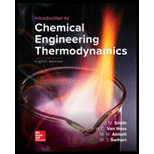
(a)
Interpretation:
A closed tank with a valve which maintain gas flow from supply line contains gas at a lower pressure than same gas in supply line at constant
Concept Introduction:
The general mass balance across any system is,
.....(1)
The energy balance for a system is:
.....(2)
(b)
Interpretation:
Reduce the general form of energy balance found in part (a) to its simplest form for the ideal gas with constant heat capacities.
Concept Introduction:
For constant specific heat
And for ideal gas,
(c)
Interpretation:
Reduce the general form of energy balance form for the ideal gas with constant heat capacities found in part (b) to its simplest form for case of
Concept Introduction:
If it is given that
(d)
Interpretation:
Reduce the general form of energy balance form for the ideal gas with constant heat capacities for case of
Concept Introduction:
If it is given that
And for ideal gas,
(e)
Interpretation:
Assume nitrogen as an ideal gas with
Concept Introduction:
Number of moles of nitrogen that flow into the tank to equalize the pressures for two cases calculated by:
Where
The heat transfer between the supply line gas with temperature
Want to see the full answer?
Check out a sample textbook solution
Chapter 3 Solutions
Introduction to Chemical Engineering Thermodynamics
 Introduction to Chemical Engineering Thermodynami...Chemical EngineeringISBN:9781259696527Author:J.M. Smith Termodinamica en ingenieria quimica, Hendrick C Van Ness, Michael Abbott, Mark SwihartPublisher:McGraw-Hill Education
Introduction to Chemical Engineering Thermodynami...Chemical EngineeringISBN:9781259696527Author:J.M. Smith Termodinamica en ingenieria quimica, Hendrick C Van Ness, Michael Abbott, Mark SwihartPublisher:McGraw-Hill Education Elementary Principles of Chemical Processes, Bind...Chemical EngineeringISBN:9781118431221Author:Richard M. Felder, Ronald W. Rousseau, Lisa G. BullardPublisher:WILEY
Elementary Principles of Chemical Processes, Bind...Chemical EngineeringISBN:9781118431221Author:Richard M. Felder, Ronald W. Rousseau, Lisa G. BullardPublisher:WILEY Elements of Chemical Reaction Engineering (5th Ed...Chemical EngineeringISBN:9780133887518Author:H. Scott FoglerPublisher:Prentice Hall
Elements of Chemical Reaction Engineering (5th Ed...Chemical EngineeringISBN:9780133887518Author:H. Scott FoglerPublisher:Prentice Hall
 Industrial Plastics: Theory and ApplicationsChemical EngineeringISBN:9781285061238Author:Lokensgard, ErikPublisher:Delmar Cengage Learning
Industrial Plastics: Theory and ApplicationsChemical EngineeringISBN:9781285061238Author:Lokensgard, ErikPublisher:Delmar Cengage Learning Unit Operations of Chemical EngineeringChemical EngineeringISBN:9780072848236Author:Warren McCabe, Julian C. Smith, Peter HarriottPublisher:McGraw-Hill Companies, The
Unit Operations of Chemical EngineeringChemical EngineeringISBN:9780072848236Author:Warren McCabe, Julian C. Smith, Peter HarriottPublisher:McGraw-Hill Companies, The





